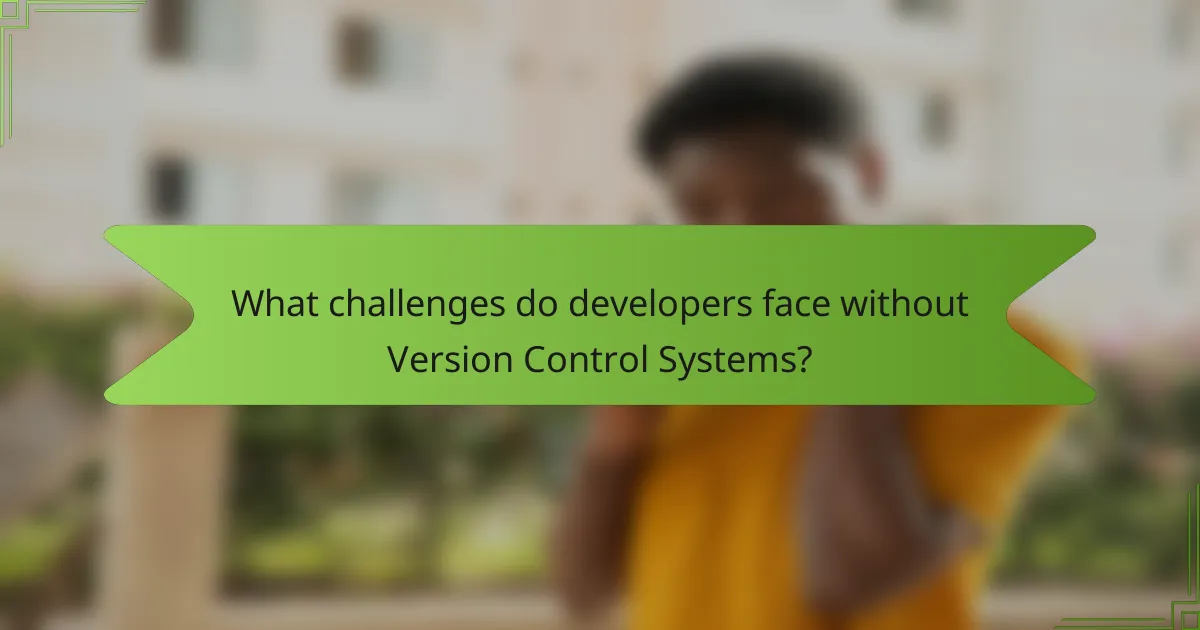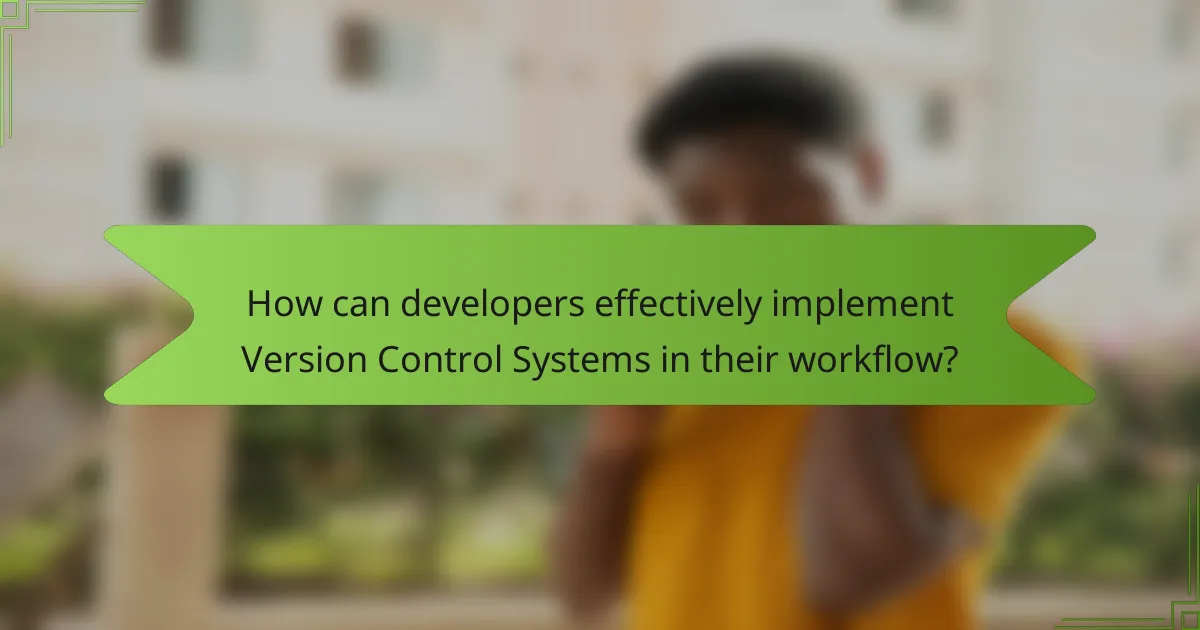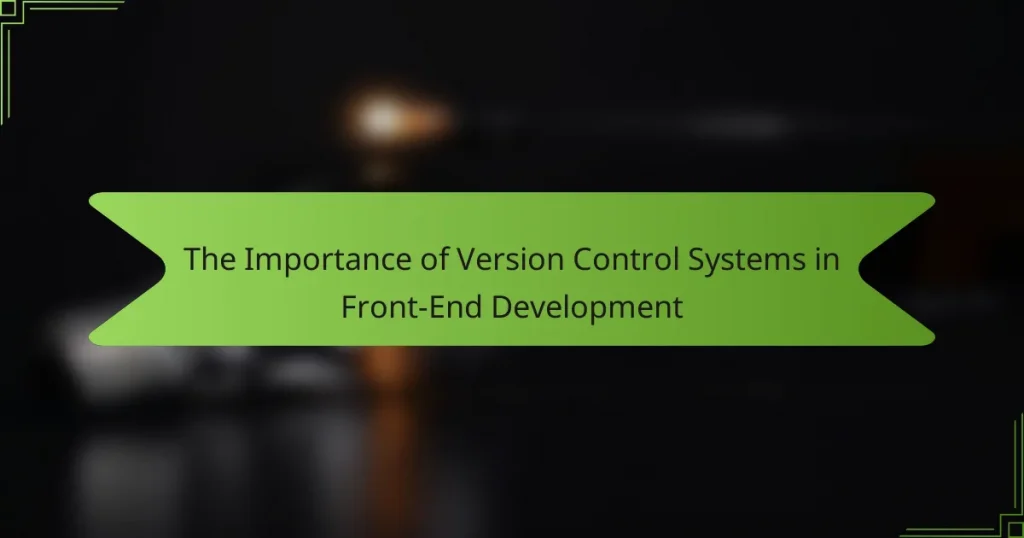Version Control Systems (VCS) are essential tools for developers, enabling them to manage changes to source code effectively over time. This article highlights the critical role of VCS in front-end development, emphasizing its benefits in collaboration, error reduction, and project management. It discusses the challenges developers face without VCS, such as code conflicts and lost work, and offers practical strategies for implementing VCS in daily workflows. By utilizing systems like Git, developers can enhance productivity, maintain code integrity, and streamline feature integration, ultimately leading to more efficient project outcomes.

What are Version Control Systems and Why are They Important in Front-End Development?
Version Control Systems (VCS) are tools that help developers manage changes to source code over time. They allow multiple developers to work on a project simultaneously while tracking modifications. VCS provides a history of changes, enabling easy collaboration and conflict resolution. In front-end development, VCS is crucial for maintaining code quality and ensuring seamless integration of features. It helps in reverting to previous versions if errors occur. According to a study by GitHub, teams that use version control experience a 50% increase in productivity. This demonstrates the significant impact of VCS on development efficiency and project management.
How do Version Control Systems function in the development process?
Version Control Systems (VCS) manage changes to source code during the development process. They allow multiple developers to collaborate on projects efficiently. VCS tracks modifications, enabling users to revert to previous versions if needed. These systems maintain a history of changes, providing context for each edit. Developers can create branches to work on features independently. Merging branches integrates changes back into the main project. VCS also resolves conflicts when multiple edits occur simultaneously. This process enhances collaboration and ensures code integrity throughout development.
What are the key components of a Version Control System?
The key components of a Version Control System (VCS) include repositories, commits, branches, and merges. A repository is a storage location for project files and their version history. Commits are snapshots of changes made to files, allowing users to track modifications over time. Branches enable parallel development by allowing separate lines of work to occur simultaneously. Merges combine changes from different branches into a single branch, integrating contributions from multiple developers. These components work together to facilitate collaboration and maintain project integrity in software development.
How do these components interact during front-end development?
Version control systems (VCS) manage changes to code during front-end development. They allow multiple developers to collaborate efficiently. Each developer can work on different components simultaneously. Changes are tracked, enabling easy integration of new features. VCS helps prevent code conflicts by merging updates systematically. It provides a history of changes, facilitating debugging and rollback if necessary. Tools like Git are widely used, supporting branching and versioning. This interaction enhances productivity and ensures code integrity throughout the development process.
What are the primary benefits of using Version Control Systems in front-end development?
Version Control Systems (VCS) provide essential benefits in front-end development. They enable collaboration among multiple developers. This collaboration is crucial for large projects with many contributors. VCS allows for tracking changes made to the codebase. This tracking helps identify who made specific changes and when. It also facilitates reverting to previous versions if needed. This is particularly useful in case of errors or bugs. Additionally, VCS supports branching and merging. These features enable developers to work on new features without disrupting the main codebase. Studies show that teams using VCS report increased productivity and reduced conflicts.
How does collaboration improve with Version Control Systems?
Collaboration improves with Version Control Systems (VCS) by enabling multiple users to work on the same project simultaneously without conflicts. VCS tracks changes made by each contributor, allowing for seamless integration of different code versions. This tracking helps in identifying who made specific changes and when, which enhances accountability.
Additionally, VCS allows for branching, enabling developers to work on features or fixes in isolation before merging them back into the main project. This reduces the risk of introducing bugs into the main codebase. Furthermore, VCS provides a history of changes, which helps teams understand the evolution of the project and facilitates easier rollbacks if needed.
Research shows that teams using VCS report a 50% increase in productivity due to improved coordination and reduced integration issues. This data underscores the effectiveness of VCS in fostering better collaboration among developers.
What role does Version Control play in project management and organization?
Version control plays a crucial role in project management and organization by tracking changes to files and facilitating collaboration. It allows multiple team members to work on the same project simultaneously without conflicts. Version control systems maintain a history of changes, enabling teams to revert to previous versions if needed. This capability enhances accountability, as it records who made specific changes and when. Additionally, version control supports branching and merging, allowing teams to experiment with new features without affecting the main project. According to research by R. R. Chikofsky and J. H. Cross, effective version control can significantly reduce errors and improve project efficiency. Thus, version control is essential for maintaining organization and ensuring smooth project workflows.

What challenges do developers face without Version Control Systems?
Developers face significant challenges without Version Control Systems (VCS). They struggle with code collaboration, leading to confusion and conflicts. Without VCS, tracking changes becomes difficult. This can result in lost work and reduced productivity. Code integrity is compromised, as developers may overwrite each other’s contributions. Reverting to previous code versions is challenging without a VCS. This increases the risk of introducing bugs. Additionally, managing project history is cumbersome, making it hard to audit changes. Overall, the absence of VCS hampers effective teamwork and project management.
How do Version Control Systems mitigate risks in front-end projects?
Version Control Systems (VCS) mitigate risks in front-end projects by enabling collaborative development and tracking changes. They allow multiple developers to work on the same codebase without conflict. VCS provides a history of changes, making it easy to revert to previous versions if issues arise. This capability reduces the likelihood of losing important work due to errors or bugs. Additionally, VCS facilitates code reviews, enhancing code quality and identifying potential problems early. According to a study by GitHub, teams using VCS report 30% fewer bugs in their projects. This statistical evidence supports the effectiveness of VCS in risk mitigation.
What common issues arise in front-end development without Version Control?
Common issues in front-end development without Version Control include loss of code, difficulty in collaboration, and challenges in tracking changes. Without version control, developers may overwrite each other’s work, leading to lost progress. Collaboration becomes cumbersome as multiple developers cannot easily merge their contributions. Tracking changes is nearly impossible, resulting in confusion over which code is the latest. Debugging becomes more complex without a history of changes to refer back to. Additionally, reverting to previous code versions is difficult, which can delay project timelines. These challenges highlight the critical need for version control in development workflows.
How can Version Control Systems prevent data loss and errors?
Version Control Systems (VCS) prevent data loss and errors by tracking changes in files and enabling easy recovery. They maintain a complete history of modifications, allowing users to revert to previous versions if needed. This feature minimizes the risk of losing work due to accidental deletions or overwrites. VCS also supports collaboration by managing multiple contributions without conflicts. When errors occur, users can identify and isolate them by reviewing the change history. This capability enhances overall project stability and reliability. According to a study by GitHub, teams using VCS report a 40% increase in productivity due to reduced errors and improved recovery processes.
What are the different types of Version Control Systems available?
The different types of Version Control Systems (VCS) available are centralized and distributed systems. Centralized Version Control Systems (CVCS) have a single central repository. Examples include Subversion (SVN) and Perforce. In CVCS, users commit changes to this central repository. This model simplifies access control and version tracking.
Distributed Version Control Systems (DVCS) allow users to have a complete copy of the repository. Git and Mercurial are prominent examples. In DVCS, users can work offline and sync changes later. This model enhances collaboration and flexibility in development workflows.
Both types serve essential roles in version management, but they cater to different workflows and team dynamics.
What distinguishes centralized Version Control from distributed Version Control?
Centralized Version Control (CVC) relies on a single central repository. In this system, all version history is stored in one location. Users check out files from this central repository. Changes are committed back to this central location. This model can lead to issues if the central server fails.
Distributed Version Control (DVC) allows each user to have a complete copy of the repository. Users can commit changes locally without needing access to a central server. This enhances collaboration and reduces dependency on a single point of failure. DVC systems like Git enable offline work and branching without affecting the main project.
The key distinction is that CVC has a single repository, while DVC provides each user with their own complete repository. This fundamental difference affects how teams collaborate and manage their code.
How do popular Version Control Systems like Git and SVN compare?
Git and SVN are both popular version control systems, but they differ significantly in their architecture and workflows. Git is a distributed version control system, meaning every developer has a full copy of the repository. This allows for offline work and faster operations. In contrast, SVN is a centralized version control system, where the repository is stored on a central server. Developers must be online to commit changes.
Git supports branching and merging as core features, enabling developers to create separate lines of development easily. SVN offers branching but it is less efficient and more cumbersome. Git’s model encourages frequent commits, which promotes better tracking of changes. SVN’s model can lead to larger, less frequent commits.
In terms of performance, Git is generally faster due to its local operations. SVN can be slower, especially with larger repositories, as it relies on server communication for most tasks. Additionally, Git has a more complex learning curve, while SVN is often seen as more straightforward for beginners.
Overall, Git is favored for its flexibility and speed, while SVN may be preferred in environments where a centralized control is necessary.

How can developers effectively implement Version Control Systems in their workflow?
Developers can effectively implement Version Control Systems (VCS) by integrating them into their daily workflow. They should begin by selecting a suitable VCS, such as Git, which is widely used and supported. Next, developers must create a repository for their project to track changes. They should consistently commit changes with clear messages to document progress. Regularly pushing changes to a remote repository ensures that work is backed up and accessible.
Additionally, developers should branch for new features or fixes to avoid disrupting the main codebase. Merging branches should be done carefully, often using pull requests to facilitate code reviews. Utilizing VCS tools, like GitHub or Bitbucket, can enhance collaboration among team members.
Research shows that teams using VCS experience increased productivity and reduced errors, as it allows for better tracking of modifications. According to a study by Perils of Version Control, teams reported fewer integration issues when using VCS effectively.
What best practices should developers follow when using Version Control Systems?
Developers should follow several best practices when using Version Control Systems (VCS). First, they should commit changes frequently. Frequent commits help track progress and make it easier to identify issues. Second, developers should write clear commit messages. Clear messages describe the purpose of the changes and enhance understanding for team members. Third, they should use branches for new features or fixes. Branching allows for isolated development, reducing risks to the main codebase. Fourth, developers need to regularly merge changes from the main branch. Regular merging minimizes conflicts and keeps the codebase up to date. Fifth, they should resolve conflicts promptly. Quick conflict resolution prevents delays in development. Lastly, developers should maintain a clean repository. A clean repository improves collaboration and reduces confusion among team members. Following these best practices enhances the effectiveness of Version Control Systems in front-end development.
How can branching and merging strategies enhance front-end development?
Branching and merging strategies enhance front-end development by allowing multiple developers to work simultaneously on different features. This approach minimizes conflicts and improves collaboration. Branching enables the isolation of new features, bug fixes, or experiments without affecting the main codebase. Developers can create branches for specific tasks, facilitating organized workflows. Merging integrates these branches back into the main project once the work is complete and tested. This ensures that the main code remains stable and functional. According to a survey by GitHub, teams using branching strategies report a 25% increase in productivity. This data supports the effectiveness of these strategies in enhancing front-end development.
What are the common pitfalls to avoid when using Version Control Systems?
Common pitfalls to avoid when using Version Control Systems include neglecting to commit often. Frequent commits help track changes and facilitate easier rollbacks. Another pitfall is failing to write meaningful commit messages. Clear messages provide context for future reference. Users often overlook branching strategies, leading to a chaotic history. Not resolving merge conflicts promptly can cause further complications. Additionally, ignoring the importance of code reviews can introduce bugs. Finally, not backing up repositories increases the risk of data loss. These practices are crucial for maintaining an efficient workflow in version control.
What resources are available for learning Version Control Systems?
Online courses on platforms like Coursera and Udacity provide structured learning on Version Control Systems. Books such as “Pro Git” by Scott Chacon and Ben Straub offer comprehensive insights. Documentation from Git’s official website serves as a reliable reference. YouTube channels dedicated to programming often feature tutorials on Version Control. Interactive platforms like Codecademy allow hands-on practice with Version Control Systems. Community forums like Stack Overflow provide peer support and problem-solving. These resources cover foundational concepts and advanced techniques effectively.
How can online courses and tutorials assist in mastering Version Control?
Online courses and tutorials can significantly enhance mastery of Version Control. They provide structured learning paths that cover essential concepts and tools. These resources often include hands-on exercises for practical experience. Interactive elements such as quizzes reinforce understanding of Version Control principles. Many courses offer real-world projects to apply learned skills. Access to expert instructors allows for clarification of complex topics. Additionally, forums and community support foster collaborative learning. Statistics show that learners using structured courses retain information more effectively than self-taught individuals.
What role do community forums and documentation play in learning?
Community forums and documentation are essential resources in the learning process. They provide a platform for users to ask questions and share knowledge. Community forums facilitate peer-to-peer learning by allowing individuals to discuss challenges and solutions. Documentation serves as a reference guide, offering structured information on tools and processes. Together, they enhance understanding and retention of complex topics. Research shows that learners who engage with community resources demonstrate improved problem-solving skills. This engagement fosters a collaborative environment that accelerates learning outcomes.
What practical tips can improve your use of Version Control Systems in front-end development?
Use clear commit messages to enhance understanding of changes. This practice helps collaborators grasp the purpose of each commit. Regularly commit your work to avoid losing progress. Frequent commits make it easier to track changes over time. Utilize branches for new features or bug fixes. This approach keeps the main codebase stable. Merge changes back into the main branch only after thorough testing. This ensures that the main branch remains functional. Familiarize yourself with rebasing and merging strategies. Understanding these concepts can prevent conflicts and streamline collaboration. Regularly pull updates from the remote repository to stay in sync with team members. This reduces the likelihood of merge conflicts. Lastly, review pull requests carefully before merging to maintain code quality. This practice encourages team collaboration and improves overall code integrity.
Version Control Systems (VCS) are essential tools in front-end development that enable developers to manage changes to source code effectively. This article outlines the functionality of VCS, including key components such as repositories, commits, branches, and merges, and highlights their importance in enhancing collaboration, maintaining code integrity, and improving project management. It also discusses the challenges developers face without VCS, the benefits of using these systems, and best practices for implementation. Additionally, the article compares popular VCS like Git and SVN, providing insights into their differences and practical tips for effective use in development workflows.


